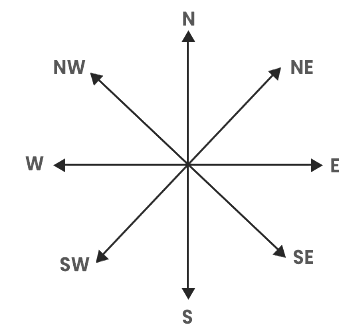Overview: Direction & Distance | General Intelligence and Reasoning for SSC CGL PDF Download
Concept
The Direction and Distance topic encompasses a wide array of question types, typically revolving around the positioning and spatial relationships between two or more individuals, objects, or entities. As such, numerous question variations can be formulated based on the location of a person, item, or product. Within this topic, we will delve into the principles and mechanics that underlie the concepts of Direction and Distance. Lets Understand.
There are four cardinal directions North (N), South (S), East (E), and West (W), and the four ordinal directions (also called the intercardinal direction) North-East (NE), North-West (NW), South-East (SE), and South -West (SW).

Tips and Tricks
- In case a person is facing east, on taking the left he will face towards the north and on taking the right turn he will face towards the south.
- In case a person is facing west, on taking the left he will face towards the south and on taking the right turn he will face towards the north.
- In case a person is facing north, on taking the left he will face towards the west and on taking the right turn he will face towards the east.
- In case a person is facing south, on taking the left he will face towards the east and on taking the right turn he will face towards the west.
Three types of Condition Based on Direction and Distance
(a) Basic Direction based question:
Example 1: Ankita is in the east of Devesh and in the north of Esha. If Gagan is in the south of Esha, then Ankita is in which direction with respect to Gagan?
Sol:
let us understand it with the help of diagrams.
Let us start with Esha, and then from there, we can draw others’ positions as well.
Hence, Ankita is towards the North of Gagan.
(b) Degree-based questions:
- If a person goes to his left side, he will go towards the anti-clockwise direction.
- If a person goes to his right side, he will go towards the clockwise direction.
* In the case of moving towards the left or right side, we assume that the movement is at an angle of 90 degrees.

in easy words we can say that:
Left turn = Anticlockwise turn
Right turn = Clockwise turn.
Example 2: Anamika is facing north. She turns 135 degrees in the anticlockwise direction and then another 180 degrees in the same direction. Find which direction she is facing now.
(a) East
(b) West
(c) North
(d) South-East
(e) North-East
Ans: e
Sol:
According to the question, she turns 135 degrees in the anticlockwise direction and then another 180 degrees in the same direction
Therefore, she turns total (135 + 180) = 315 degree anticlockwise
Hence, she turns 315 degrees to her left side.
In the primary stage if she faces north then, finally she will face the North-East direction.
(c) Coded Direction based question:
In such types of questions, the directions are given in a certain coded language.
Example: Direction: Study the following information carefully and answer the questions given below.
In a coded language:
- A@B (11) means A is 11m in the north of B
- A*B (26) means A is 26m in the south of B
- A&B (18) means A is 18m in the east of B
- A~B (21) means A is 21m in the west of B
N@M (11), O~N (13), P*O (11), Q&P (18); Then, M is in which direction with respect to Q?
(a) North
(b) West
(c) North-west
(d) East
(e) South-east
Ans: b
Sol:
M is in the west direction with respect to Q.
Note: To find the Shortest Distance between any two points:
Use the formula of Pythagoras’ theorem i.e., H2 = √(P2+B2 )
|
177 videos|126 docs|197 tests
|
FAQs on Overview: Direction & Distance - General Intelligence and Reasoning for SSC CGL
| 1. What is direction and distance in relation to navigation? |  |
| 2. How can direction and distance be determined in navigation? |  |
| 3. How does a compass help in determining direction? |  |
| 4. What role does distance play in navigation? |  |
| 5. What are some common units used to measure distance in navigation? |  |






















